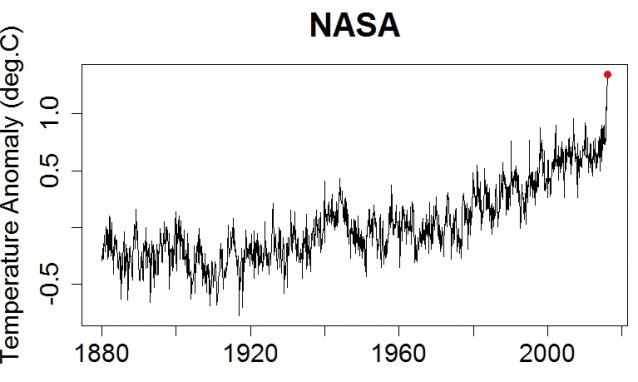We can have a healthy climate — a climate with zero warming — in our lifetimes. The message for the last 20 years has been that we have to reduce emissions drastically to prevent dangerous climate change of more than 2 degrees C (3.6 F). This strategy would have likely worked when it was first suggested, but we have delayed …
Biofuels increase, rather than decrease, heat-trapping carbon dioxide emissions: study
A new study from University of Michigan researchers challenges the widely held assumption that biofuels such as ethanol and biodiesel are inherently carbon neutral. Contrary to popular belief, the heat-trapping carbon dioxide gas emitted when biofuels are burned is not fully balanced by the CO2 uptake that occurs as the plants grow, according to a study by research professor John DeCicco and …
NASA/Goddard Space Flight Center – 2016 climate trends continue to break records
Two key climate change indicators — global surface temperatures and Arctic sea ice extent — have broken numerous records through the first half of 2016, according to NASA analyses of ground-based observations and satellite data. Each of the first six months of 2016 set a record as the warmest respective month globally in the modern temperature record, which dates to …
World’s carbon dioxide concentration teetering on the point of no return
The world is hurtling towards an era when global concentrations of carbon dioxide never again dip below the 400 parts per million (ppm) milestone, as two important measuring stations sit on the point of no return. The news comes as one important atmospheric measuring station at Cape Grim in Australia is poised on the verge of 400ppm for the first …
John V. Walsh – China Closes the Innovation Gap
The headline reads, “The Rapid Rise of a Research Nation: China’s economic boom is mirrored by its similarly meteoric rise in high quality science.” This was not a headline in People’s Daily or China Daily but in the most prestigious of Western scientific publications, Nature. The 38 pages, which follow that headline in a special Supplement to the journal Nature, tell us that China is now second …
‘There is No Doubt’: Exxon Knew CO2 Pollution Was A Global Threat By Late 1970s
Throughout Exxon’s global operations, the company knew that CO2 was a harmful pollutant in the atmosphere years earlier than previously reported. DeSmog has uncovered Exxon corporate documents from the late 1970s stating unequivocally “there is no doubt” that CO2 from the burning of fossil fuels was a growing “problem” well understood within the company. “It is assumed that the major …
Unhealthy ozone days could increase by more than a week in coming decades
If emission rates continue unchecked, regions of the United States could experience between three and nine additional days per year of unhealthy ozone levels by 2050, according to a new study from the Harvard John A. Paulson School of Engineering and Applied Sciences (SEAS) published in Geophysical Research Letters. “In the coming decades, global climate change will likely cause more heat …
Ugo Barti – The climate emergency: time to switch to panic mode?
The latest temperature data have broken all records (image from “think progress“). At best, this is an especially large oscillation and the climate system will be soon back on track; following the predictions of the models – maybe to be retouched to take into account faster climbing temperatures. A worst, it is an indication that the system is going out …
Fuel or food? Study sees increasing competition for land, water resources
About 4 percent of the world’s agricultural land and 3 to 4 percent of its fresh water are now used for growing biofuels, according to a new study published March 3, 2016 in the Nature journal Scientific Reports. About one-third of the malnourished people in the world, the findings suggest, could be fed by using these resources for food production. With …
Emissions could make Earth uninhabitable
Greenhouse gases could tip the Earth – or at least a planet like Earth, orbiting a star very like the Sun – into a runaway greenhouse effect, according to new research. The new hothouse planet would become increasingly steamy, and then start to lose its oceans to interplanetary space. Over time, it would become completely dry, stay at a temperature …










